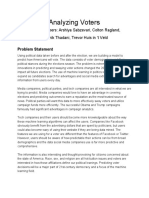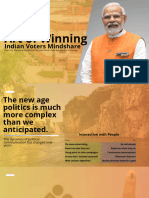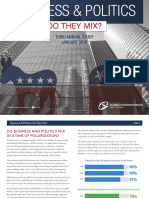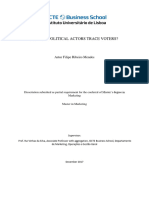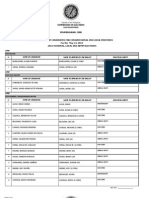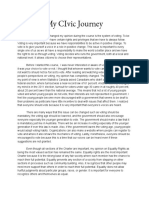MICROTARGETING: KNOWING THE VOTER INTIMATELY
Winning Campaigns Magazine, Vol. 4, No.1
The Hotline recently declared that MicroTargeting stories were “overserved” – that is, too many
media outlets doing too many stories about how the car you drive or the coffee you drink
determine how you vote. But beyond a fairly shallow pass at the methodology, there has been
little substantive discussion among political professionals about why MicroTargeting is
necessary and how it all works.
What is MicroTargeting?
MicroTargeting is a new tool for candidates and campaigns that answers their most fundamental
questions: Who supports my candidate? Where do I find them? How do I persuade others to
support my candidate? When done right, MicroTargeting answers each of these questions and
does it in ways traditional targeting cannot.
The process works at the crossroads of three related disciplines: customer relationship
management technologies, advanced marketing techniques and traditional political targeting. By
merging together the best practices of the fields, MicroTargeting can sequence each individual
voter’s unique political DNA to identify their likely political attitudes and behaviors.
Ultimately, MicroTargeting informs, sharpens, and increases the efficiency of a campaign’s
direct voter contact plans, allowing them to send individually targeted messages delivered by the
proper messengers For example, a group of “Flag and Family Republicans” might receive
literature on a flag-burning amendment from its sponsor, while “Tax and Terrorism Moderates”
get an automated call from Rudy Giuliani talking about the War on Terror, even if they lived
right next door to each other.
The MicroTargeting Philosophy
Yes, the car you drive and the coffee you drink may have something to do with how you vote,
but what if that SUV you drive is hybrid? What if the driver is a married man living in Sioux
Falls? What if that Starbucks drinker is sipping in an evangelical coffee house? What if this
bible-reader also belongs to Greenpeace? How does the aggregate effect of each data point
increase or decrease the likelihood a voter will support your side?
MicroTargeting begins with this basic assumption: that no single data point can tell you the
whole story. Survey research that focuses on crosstabs such as income, gender, race and other
demographics only provide a fraction of the story. Looking at the interaction between the
various data provides a far more detailed look at your voters.
By using hundreds of data points, comprised of voter information, life cycle information, life
style information, financial data, consumer behavior, geographic data, and political attitudes and
preferences, MicroTargeting can be used to segment each of your voters into one of a number of
mutually exclusive groups, each defined by a unique combination of a host of data points.
�In the end there is no “killer” data point that explains our political preferences, but looking at the
sum total of our lifelong data trail gets us extremely close.
Why Now?
In a word: technology. Campaigns have always collected data on their voters, and there have
always been mounds of census data, polling crosstabs and voter registration files. Unfortunately,
that data was in most cases wholly insufficient to get the job done, or too large and complex for
anything more than rough approximations, oversimplified target lists, and statistically
insignificant intuition. Technological developments have brought desperately needed depth and
clarity to our formerly flat and hazy perception of individual voters.
So while blogs, podcasts and YouTube have taken center stage in the poli-tech revolution, other
more radical technology has allowed MicroTargeting to become the force that it is today: 1) the
ability to digitally store and archive massive amounts of raw data, 2) the growth in the quantity
and quality of multi-sourced consumer information, 3) the ability to link multiple data islands
such as voter files, geographic data, etc., and 4) the analytical power to search and discover new,
meaningful patterns and relationships of strategic and tactical value.
MicroTargeting erases the data inefficiencies of the past, giving candidates, campaign managers
and other political professionals the precision, accuracy and statistical validity they need to win.
And as technology continues to progress, the speed, efficiency and cost effectiveness of
MicroTargeting will improve – we have only seen the simple beginnings of something that
promises to be a potent tool.
The Shortcomings of Traditional Targeting
Naturally, there are skeptics—those tacticians that have had success with geographic, partisan,
and turnout profiles to drive their direct contact programs. Precincts that voted more than 65%
Republican would be blanketed with door knocks; registered Democrats would get mail about
the candidate’s education program; “two of four” voters would get reminder phone calls to vote.
But relying too heavily on geography, party registration and electoral turnout alone leaves some
of your best voters stranded and untouched. Think of that blue-collar Independent that sat out the
last election and lives in an overwhelmingly Democratic precinct – traditional GOP targeting
most likely leaves that voter untouched. MicroTargeting allows you to look at that voter and see
that he is also drives a truck, owns a gun, has three kids and is very angry about illegal
immigration. MicroTargeting not only adds him and others just like him to your pool of
potential voters, but it also allows you to communicate with them more effectively. It is the
difference between shouting to a group and speaking intimately with each individual voter.
MicroTargeting becomes the campaign’s search and rescue mission, connecting the campaign
with supporters that would have remained untouched under traditional targeting programs. It
gets votes that traditional targeting didn’t even know were there.
�The Changing Consumer Landscape
This search and rescue methodology couldn’t have come at a better time. The world is changing
and so is the way you run political campaigns.
Broadcasting is a thing of yesterday, when three television networks commanded 80% of
Americans – replaced today by the narrow-casting of hundreds of channels, thousands of satellite
radio stations and millions upon millions of websites and blogs. This fragmentation of media
and information sources has placed an even greater premium on one-on-one direct marketing of
candidates and campaign themes.
Electoral tactics must therefore return to their roots of peer-to-peer communications, mail,
phones, emails and door knocks to deliver their message – and the MicroTargeting process is
useless without the direct voter contact plan and budget to back it up. These mass appeals arrive
customized to each individual voter’s attitudes and preferences, providing a campaign mailer
fitted directly to the issues, themes, messages and messengers that resonate the most with each
voter in your contact universe.
The Future of Campaigning
MicroTargeting has undoubtedly changed the face of political campaigning and regardless of its
critics, it is here to stay. Indeed, independent validation studies of its predictive power have only
confirmed its accuracy.
Nonetheless, all of its hype makes it both easy and tempting to see it as a turnkey, computer-
generated “miracle” solution for the challenges of a modern political campaign. It isn’t a
solution – it’s a tool. And like any tool, it is a collaborative, strategic decision-making process
between the MicroTargeting team and the campaign.
At the end of the day, MicroTargeting becomes another arrow in the campaign quiver – an arrow
your opponent likely already has. By itself though, MicroTargeting will never win any
campaign, but used appropriately in a tight election it can provide the competitive edge you need
to win.













